Assessing Travel-Time Accessibility to Urban Green Spaces in Car-Dependent Cities: Evidence from Erbil and Sulaimaniyah, Kurdistan Region of Iraq
Abstract
1. Introduction
1.1. UGS and Sustainability
1.2. Definitions and Classifications of UGS
1.3. The Concept of Accessibility and UGS Accessibility in Urban Studies
1.4. Inequity in UGS Accessibility and Gaps
1.5. Car Dependency and Sustainability Concerns
1.6. Urban Growth and Car Dependency in the Kurdistan Region of Iraq
1.7. Case Studies Justification
1.8. Emerging Opportunities for Car-Based Accessibility and Comparative Evidence vs. Public Transport
1.9. Research Gap: Car-Based Accessibility to UGS in KRI
1.10. Research Objectives and Key Questions
- What are the spatial distributions of vegetation; green space; and LUGS, their corresponding entrances, and the population in both case cities?
- What is the quality of the LUGS in terms of vegetative cover proportion?
- What are the areas of LUGS and the corresponding population coverage at the city level, as determined using the ORS method based on active gates?
- How does the enhanced method affect car accessibility?
- What are the zonal disparities in car access to LUGS?
- How can we identify the best-performing LUGS considering the number of gates, location in the urban hierarchy, and the density of the surrounding population?
- What are the spatial equity and disparities in the cities and zonal areas?
2. Materials and Methods
2.1. Data Collection
2.2. Case Studies
2.3. Data Analysis
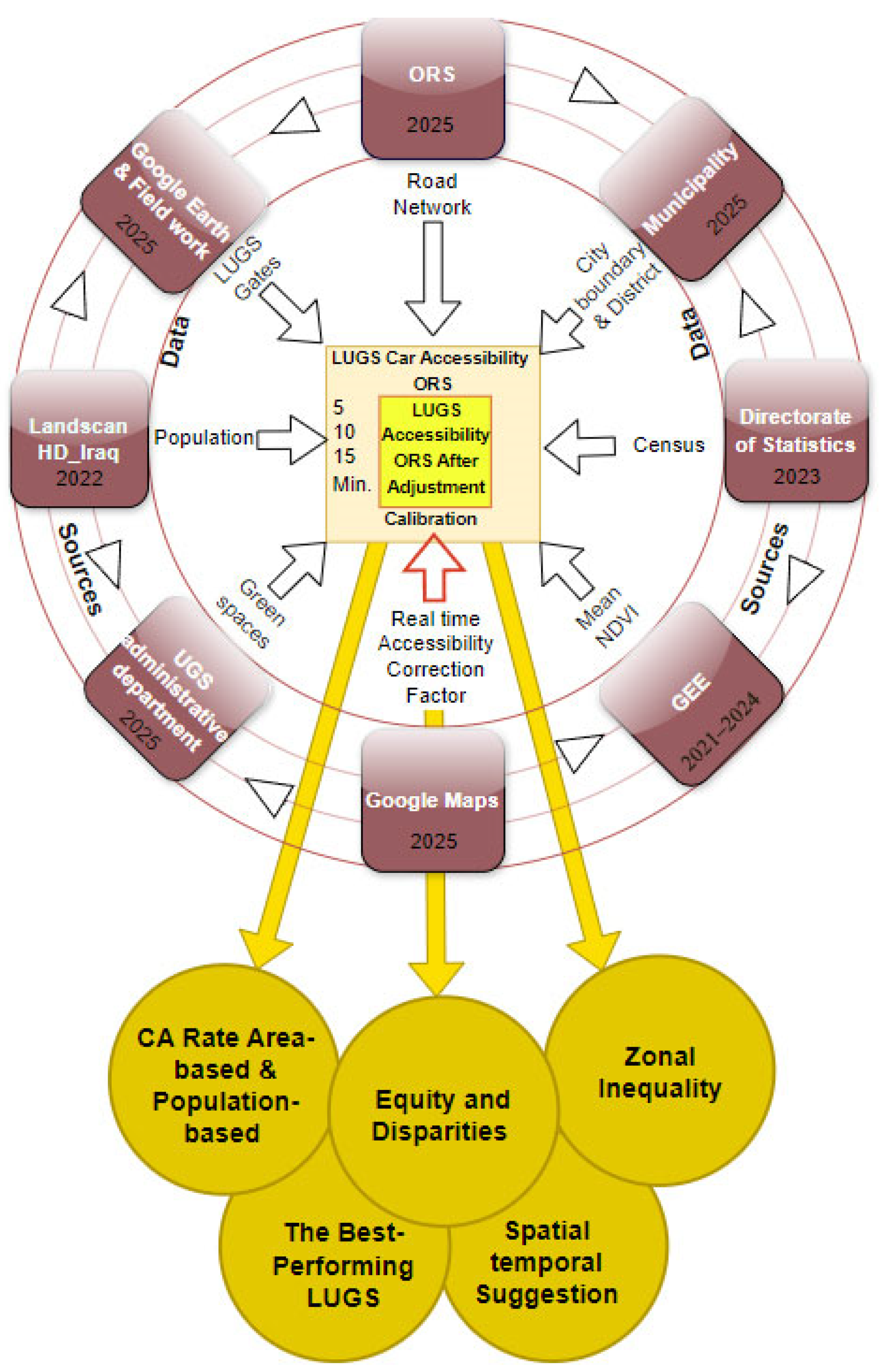
3. Results
3.1. Spatial Distribution of the Vegetation, Green Space, and LUGS
3.2. Vegetation Covers of LUGS
3.3. Population and Served Area of CA Using ORS
3.4. Enhanced Car Accessibility
3.5. Zonal Disparities in Car Access to LUGS
3.6. Main Determinants and Best Performances in Car Accessibility to LUGS
3.7. Equity and Disparities
4. Discussion
5. Conclusions
Author Contributions
Funding
Conflicts of Interest
References
- Aronson, M.F.; Lepczyk, C.A.; Evans, K.L.; Goddard, M.A.; Lerman, S.B.; MacIvor, J.S.; Nilon, C.H.; Vargo, T. Biodiversity in the city: Key challenges for urban green space management. Front. Ecol. Environ. 2017, 15, 189–196. [Google Scholar] [CrossRef]
- Gill, S.E.; Handley, J.F.; Ennos, A.R.; Pauleit, S. Adapting cities for climate change: The role of the green infrastructure. Built Environ. 2007, 33, 115–133. [Google Scholar] [CrossRef]
- Bowler, D.E.; Buyung-Ali, L.; Knight, T.M.; Pullin, A.S. Urban greening to cool towns and cities: A systematic review of the empirical evidence. Landsc. Urban Plan. 2010, 97, 147–155. [Google Scholar] [CrossRef]
- Jombach, S.; Üsztöke, L.; Hassan, Y.N.; Chenyu, D. Green Space Intensity, Land Surface Temperature and Green Canopy Top Mapping: A Case Study in the Suburban Settlement of Törökbálint, Hungary. J. Digit. Landsc. Archit. 2023, 8, 417–425. [Google Scholar] [CrossRef]
- Hoover, F.-A.; Hopton, M.E. Developing a framework for stormwater management: Leveraging ancillary benefits from urban greenspace. Urban Ecosyst. 2019, 22, 1139–1148. [Google Scholar] [CrossRef] [PubMed]
- Gharibi, S.; Shayesteh, K.; Attaiean, B. The Capability of Urban Green Spaces in providing Carbon Sequestration Ecosystem Services. Geogr. Environ. Sustain. 2021, 11, 61–80. [Google Scholar]
- Dadvand, P.; Bartoll, X.; Basagaña, X.; Dalmau-Bueno, A.; Martinez, D.; Ambros, A.; Cirach, M.; Triguero-Mas, M.; Gascon, M.; Borrell, C.; et al. Green spaces and general health: Roles of mental health status, social support, and physical activity. Environ. Int. 2016, 91, 161–167. [Google Scholar] [CrossRef]
- Abulibdeh, A. Analysis of urban heat island characteristics and mitigation strategies for eight arid and semi-arid gulf region cities. Environ. Earth Sci. 2021, 80, 259. [Google Scholar] [CrossRef]
- Scholes, R.J. The future of semi-arid regions: A weak fabric unravels. Climate 2020, 8, 43. [Google Scholar] [CrossRef]
- Gupta, K.; Puntambekar, K.; Roy, A.; Pandey, K.; Mahavir; Kumar, P. Smart environment through smart tools and technologies for urban green spaces: Case study: Chandigarh, India. In Smart Environment for Smart Cities; Springer: Berlin/Heidelberg, Germany, 2019; pp. 149–194. [Google Scholar]
- United Nations General Assembly. Transforming our world: The 2030 agenda for sustainable development. In Springer eBooks; Springer: Berlin/Heidelberg, Germany, 2015. [Google Scholar] [CrossRef]
- Duke, J.A. Three Men in the Wilderness: Ideas and Concepts of Nature During the Progressive Era with Theodore Roosevelt, Gifford Pinchot and John Muir. Master’s Thesis, University of Northern Iowa, Cedar Falls, IA, USA, 2016. [Google Scholar]
- Yang, B.; Li, S. Design with Nature: Ian McHarg’s ecological wisdom as actionable and practical knowledge. Landsc. Urban Plan. 2016, 155, 21–32. [Google Scholar] [CrossRef]
- Rosenberg, E. Public and private: Rereading jane Jacobs. Landsc. J. 1994, 13, 139–144. [Google Scholar] [CrossRef]
- Mercer, C. Geographics for the present: Patrick Geddes, urban planning and the human sciences. Int. J. Hum. Resour. Manag. 1997, 26, 211–232. [Google Scholar] [CrossRef]
- Marcus, C.C.; Francis, C. People Places: Design Guidlines for Urban Open Space; John Wiley & Sons: Hoboken, NJ, USA, 1997. [Google Scholar]
- Grabowski, Z.J.; McPhearson, T.; Matsler, A.M.; Groffman, P.; Pickett, S.T. What is green infrastructure? A study of definitions in US city planning. Front. Ecol. Environ. 2022, 20, 152–160. [Google Scholar] [CrossRef]
- Choi, D.-A.; Park, K.; Rigolon, A. From XS to XL urban nature: Examining access to different types of green space using a ‘just sustainabilities’ framework. Sustainability 2020, 12, 6998. [Google Scholar] [CrossRef]
- Gozalo, G.; Morillas, J.; González, D. Perceptions and use of urban green spaces on the basis of size. Urban Urban Green 2019, 46, 126470. [Google Scholar] [CrossRef]
- Geurs, K.T.; Van Wee, B. Accessibility evaluation of land-use and transport strategies: Review and research directions. J. Transp. Geogr. 2004, 12, 127–140. [Google Scholar] [CrossRef]
- Hansen, W.G. Accessibility and Residential Growth. Master’s Thesis, Massachusetts Institute of Technology, Cambridge, MA, USA, 1959. [Google Scholar]
- Ben-Akiva, M.; Lerman, S.R. Disaggregate travel and mobility-choice models and measures of accessibility. In Behavioural Travel Modelling; Routledge: London, UK, 2021; pp. 654–679. [Google Scholar]
- Talen, E. Sense of community and neighbourhood form: An assessment of the social doctrine of new urbanism. Urban Stud. 1999, 36, 1361–1379. [Google Scholar] [CrossRef]
- Páez, A.; Scott, D.M.; Morency, C. Measuring accessibility: Positive and normative implementations of various accessibility indicators. J. Transp. Geogr. 2012, 25, 141–153. [Google Scholar] [CrossRef]
- Luo, W.; Qi, Y. An enhanced two-step floating catchment area (E2SFCA) method for measuring spatial accessibility to primary care physicians. Health Place 2009, 15, 1100–1107. [Google Scholar] [CrossRef] [PubMed]
- Higgs, G.; Fry, R.; Langford, M. Investigating the implications of using alternative GIS-based techniques to measure accessibility to green space. Environ. Plan. B Plan. Des. 2012, 39, 326–343. [Google Scholar] [CrossRef]
- Chen, P.; Wang, W.; Qian, C.; Cao, M.; Yang, T. Gravity-based models for evaluating urban park accessibility: Why does localized selection of attractiveness factors and travel modes matter? Environ. Plan. B Urban Anal. City Sci. 2024, 51, 904–922. [Google Scholar] [CrossRef]
- Williams, C.; Williams, C.; Byrne, C.; Evenden, S.; Soebarto, V.; Caddy-Retalic, S.; Williams, C.; Tefera, Y.; Feng, X.; Lowe, A. Urban green space provision: The case for policy-based solutions to support human health. Med. J. Aust. 2025, 222, 110–113. [Google Scholar] [CrossRef]
- Boone, C.G.; Buckley, G.L.; Grove, J.M.; Sister, C. Parks and people: An environmental justice inquiry in Baltimore, Maryland. Ann. Assoc. Am. Geogr. 2009, 99, 767–787. [Google Scholar] [CrossRef]
- Wolch, J.R.; Byrne, J.; Newell, J.P. Urban green space, public health, and environmental justice: The challenge of making cities ‘just green enough’. Landsc. Urban Plan. 2014, 125, 234–244. [Google Scholar] [CrossRef]
- Nesbitt, L.; Meitner, M.J.; Girling, C.; Sheppard, S.R.; Lu, Y. Who has access to urban vegetation? A spatial analysis of distributional green equity in 10 US cities. Landsc. Urban Plan. 2019, 181, 51–79. [Google Scholar] [CrossRef]
- Chen, B.; Wu, S.; Song, Y.; Webster, C.; Xu, B.; Gong, P. Contrasting inequality in human exposure to greenspace between cities of Global North and Global South. Nat. Commun. 2022, 13, 4636. [Google Scholar] [CrossRef]
- Koohsari, M.J. Access to public open space: Is distribution equitable across different socio-economic areas. J. Urban Environ. Eng. 2011, 5, 67–72. [Google Scholar] [CrossRef]
- Tan, P.Y.; Samsudin, R. Effects of spatial scale on assessment of spatial equity of urban park provision. Landsc. Urban Plan. 2017, 158, 139–154. [Google Scholar] [CrossRef]
- Lee, G.; Hong, I. Measuring spatial accessibility in the context of spatial disparity between demand and supply of urban park service. Landsc. Urban Plan. 2013, 119, 85–90. [Google Scholar] [CrossRef]
- Wang, C.; Wang, S.; Cao, Y.; Yan, H.; Li, Y. The social equity of urban parks in high-density urban areas: A case study in the core area of Beijing. Sustainability 2023, 15, 13849. [Google Scholar] [CrossRef]
- Nasri Roodsari, E.; Hoseini, P. An assessment of the correlation between urban green space supply and socio-economic disparities of Tehran districts—Iran. Environ. Dev. Sustain. 2022, 24, 12867–12882. [Google Scholar] [CrossRef]
- Hassan, Y.N.; Zhen, S.; Sharbazhery, A.O.; Du, C.; Jombach, S. Evaluating Urban Green Space Accessibility and Per Capita Distribution in Erbil and Sulaymaniyah, Kurdistan Region of Iraq. In Fábos Conference on Landscape and Greenway Planning; University of Massachusetts Amherst Libraries: Amherst, MA, USA, 2025. [Google Scholar] [CrossRef]
- Iraegui, E.; Augusto, G.; Cabral, P. Assessing equity in the accessibility to urban green spaces according to different functional levels. ISPRS Int. J. Geo-Inf. 2020, 9, 308. [Google Scholar] [CrossRef]
- Hassan, Y.N.; Ali, Z.F.; Üsztöke, L.; Jombach, S. A Comparative Assessment of UGS Changes and Accessibility Using Per Capita Metrics: A Case Study of Budapest and Vienna. J. Digit. Landsc. Archit. 2024, 9, 723–734. [Google Scholar] [CrossRef]
- Biernacka, M.; Kronenberg, J.; Łaszkiewicz, E.; Czembrowski, P.; Parsa, V.A.; Sikorska, D. Beyond urban parks: Mapping informal green spaces in an urban–peri-urban gradient. Land Use Policy 2023, 131, 106746. [Google Scholar] [CrossRef]
- Buckland, M.; Pojani, D. Green space accessibility in Europe: A comparative study of five major cities. Eur. Plan. Stud. 2023, 31, 146–167. [Google Scholar] [CrossRef]
- Kabisch, N.; Haase, D. Green justice or just green? Provision of urban green spaces in Berlin, Germany. Landsc. Urban Plan. 2014, 122, 129–139. [Google Scholar] [CrossRef]
- Hoffimann, E.; Barros, H.; Ribeiro, A.I. Socioeconomic inequalities in green space quality and accessibility—Evidence from a Southern European city. Int. J. Environ. Res. Public Health 2017, 14, 916. [Google Scholar] [CrossRef]
- Donaldson, R.; Ferreira, S.; Didier, S.; Rodary, E.; Swanepoel, J. Access to the urban national park in Cape Town: Where urban and natural environment meet. Habitat Int. 2016, 57, 132–142. [Google Scholar] [CrossRef]
- Ibes, D.C. A multi-dimensional classification and equity analysis of an urban park system: A novel methodology and case study application. Landsc. Urban Plan. 2015, 137, 122–137. [Google Scholar] [CrossRef]
- Ayala-Azcarraga, C.; Diaz, D.; Fernandez, T.; Cordova-Tapia, F.; Zambrano, L. Uneven distribution of urban green spaces in relation to marginalization in Mexico City. Sustainability 2023, 15, 12652. [Google Scholar] [CrossRef]
- Ramos, A.G.; Garcia-Macias, J.A. Where Google Maps Doesn’t Go: Mobility Decisions of People in Underserved Neighborhoods. In Proceedings of the 13th International Conference on Ubiquitous Computing and Ambient Intelligence UCAmI 2019, Toledo, Spain, 2–5 December 2019; Volume 31, p. 77. [Google Scholar]
- Erath, A.; van Eggermond, M.A.; Ordóñez, S.A.; Axhausen, K.W. Introducing the pedestrian accessibility tool: Walkability analysis for a geographic information system. Transp. Res. Rec. 2017, 2661, 51–61. [Google Scholar] [CrossRef]
- Zhang, R.; Huang, L.; Wang, H. Accessibility improvement and renewal of urban park green space for the elderly and the disabled. Forests 2023, 14, 1801. [Google Scholar] [CrossRef]
- Chang, Z.; Chen, J.; Li, W.; Li, X. Public transportation and the spatial inequality of urban park accessibility: New evidence from Hong Kong. Transp. Res. Part D Transp. Environ. 2019, 76, 111–122. [Google Scholar] [CrossRef]
- Nieuwenhuijsen, M.J. Urban and transport planning pathways to carbon neutral, liveable and healthy cities; A review of the current evidence. Environ. Int. 2020, 140, 105661. [Google Scholar] [CrossRef]
- Lucas, K.; Van Wee, B.; Maat, K. A method to evaluate equitable accessibility: Combining ethical theories and accessibility-based approaches. Transportation 2016, 43, 473–490. [Google Scholar] [CrossRef]
- ElDeeb, S.; EL-Baky, R.A.A.; Masoumi, H. Unveiling transportation disparities: Investigating accessibility gaps in metropolitan cities using GIS—A case study of Alexandria, Egypt. Front. Sustain. Cities 2024, 6, 1372918. [Google Scholar] [CrossRef]
- Un-Habitat. Planning and Design for Sustainable Urban Mobility: Global Report on Human Settlements 2013; Taylor & Francis: Abingdon, UK, 2013. [Google Scholar]
- Sun, Y.; Saha, S.; Tost, H.; Kong, X.; Xu, C. Literature review reveals a global access inequity to urban green spaces. Sustainability 2022, 14, 1062. [Google Scholar] [CrossRef]
- Glazener, A.; Wylie, J.; van Waas, W.; Khreis, H. The impacts of car-free days and events on the environment and human health. Curr. Environ. Health Rep. 2022, 9, 165–182. [Google Scholar] [CrossRef]
- Himanen, V.; Nijkamp, P.; Padjen, J. Transport Mobility, Spatial Accessibility and Environmental Sustainability; Vrije Universiteit Amsterdam: Amsterdam, The Netherlands, 1992. [Google Scholar]
- Will, M.-E.; Cornet, Y.; Munshi, T. Measuring road space consumption by transport modes: Toward a standard spatial efficiency assessment method and an application to the development scenarios of Rajkot City, India. J. Transp. Land Use 2020, 13, 651–669. [Google Scholar] [CrossRef]
- Al-Obaedi, J.T.S. Highlighting the Ongoing Roads Infrastructure Challenges: Car Ownership Rates in Iraq. Univ. Thi-Qar J. Eng. Sci. 2019, 10, 1–4. [Google Scholar] [CrossRef]
- 964media. Kurdistan Region Sees Surge in Vehicle Imports with over 171,000 Cars Entering in 2024. 2025. Available online: https://en.964media.com/30363/ (accessed on 10 June 2025).
- Kurdistan Region Statistics Office. Kurdistan Region of Iraq—Population Analysis Report 2021; Kurdistan Region Statistics Office: Erbil, Iraq, 2021.
- Rigolon, A. A complex landscape of inequity in access to urban parks: A literature review. Landsc. Urban Plan. 2016, 153, 160–169. [Google Scholar] [CrossRef]
- Field, M.J.; Jette, A.M.; Institute of Medicine (US) Committee on Disability in America. Transportation Patterns and Problems of People with Disabilities, in the Future of Disability in America; National Academies Press (US): Washington, DC, USA, 2007. [Google Scholar]
- Zeng, T.; Zhang, H.; Moura, S.J.; Shen, Z.J.M. Economic and environmental benefits of automated electric vehicle ride-hailing services in New York City. Sci. Rep. 2024, 14, 4180. [Google Scholar] [CrossRef] [PubMed]
- Golbabaei, F.; Dwyer, J.; Gomez, R.; Peterson, A.; Cocks, K.; Bubke, A.; Paz, A. Enabling mobility and inclusion: Designing accessible autonomous vehicles for people with disabilities. Cities 2024, 154, 105333. [Google Scholar] [CrossRef]
- Pinto, L.V.; Ferreira, C.S.S.; Inácio, M.; Pereira, P. Urban green spaces accessibility in two European cities: Vilnius (Lithuania) and Coimbra (Portugal). Geogr. Sustain. 2022, 3, 74–84. [Google Scholar] [CrossRef]
- Qin, J.; Liu, Y.; Yi, D.; Sun, S.; Zhang, J. Spatial accessibility analysis of parks with multiple entrances based on real-time travel: The case study in Beijing. Sustainability 2020, 12, 7618. [Google Scholar] [CrossRef]
- Liu, L.; Zheng, B.; Luo, C.; Bedra, K.B.; Masrabaye, F. Access to city center: Automobile vs. public transit. Int. J. Environ. Res. Public Health 2022, 19, 5622. [Google Scholar] [CrossRef] [PubMed]
- Conwell, L.; Eckert, F.; Mobarak, A.M. Transportation Infrastructure and City-Center Accessibility in the US and Europe. 2023. Available online: https://www.fpeckert.me/CEM.pdf (accessed on 25 June 2025).
- Kemec, S.; Abdalkarim, S.H. Accessibility analysis of urban green space: The case of Erbil city. ICONARP Int. J. Archit. Plan. 2023, 11, 24–44. [Google Scholar] [CrossRef]
- Downward, P.; Lumsdon, L. Tourism transport and visitor spending: A study in the North York Moors National Park, UK. J. Travel Res. 2004, 42, 415–420. [Google Scholar] [CrossRef]
- Pettebone, D.; Newman, P.; Lawson, S.R.; Hunt, L.; Monz, C.; Zwiefka, J. Estimating visitors’ travel mode choices along the bear lake road in Rocky Mountain National Park. J. Transp. Geogr. 2011, 19, 1210–1221. [Google Scholar] [CrossRef]
- Ermida, S.L.; Soares, P.; Mantas, V.; Göttsche, F.M.; Trigo, I.F. Google earth engine open-source code for land surface temperature estimation from the landsat series. Remote Sens. 2020, 12, 1471. [Google Scholar] [CrossRef]
- OpenRouteService. Openrouteservice API Services. 2025. Available online: https://openrouteservice.org/ (accessed on 5 June 2025).
- Hecht, R.; Gröbe, M.; Gugulica, M.; Krellenberg, K.; Kreutzarek, N.; Lautenbach, S. A web app to generate and disseminate new knowledge on urban green space qualities and their accessibility. ISPRS Ann. Photogramm. Remote Sens. Spat. Inf. Sci. 2021, 8, 65–72. [Google Scholar] [CrossRef]
- Ibrahim, R.I.; Mushatat, S.A.; Abdelmonem, M.G. Erbil. Cities 2015, 49, 14–25. [Google Scholar] [CrossRef]
- Acheampong, R.A.; Asabere, S.B. Urban expansion and differential accessibility by car and public transport in the Greater Kumasi city-region, Ghana—A geospatial modelling approach. J. Transp. Geogr. 2022, 98, 103257. [Google Scholar] [CrossRef]
- Sabr, C. A study on the urban form of Erbil city (the capital of Kurdistan region) as an example of historical and fast growing city. Humanit. Soc. Sci. Rev. CD-ROM 2014, 3, 325–340. [Google Scholar]
- Talen, E. Neighborhoods as service providers: A methodology for evaluating pedestrian access. Environ. Plan. B Plan. Des. 2003, 30, 181–200. [Google Scholar]
- Gavrilidis, A.A.; Popa, A.M.; Nita, M.R.; Onose, D.A.; Badiu, D.L. Planning the “unknown”: Perception of urban green infrastructure concept in Romania. Urban For. Urban Green. 2020, 51, 126649. [Google Scholar] [CrossRef]
- Pereira, P.; Baró, F. Greening the City: Thriving for Biodiversity and Sustainability; Elsevier: Amsterdam, The Netherlands, 2022; p. 153032. [Google Scholar]
- K Alfaris, S. The Green Network Panoramic Vision Erbil City as a Case Study. Cihan Univ.–Erbil Sci. J. (CUESJ) 2022, 6, 2. [Google Scholar]
- Salih, A.M.; Erfani, G.; Larimian, T. Mass housing planning and environmental considerations: Case studies of post-war urban redevelopment in Erbil city, Kurdistan. Local Environ. 2025, 1–21. [Google Scholar] [CrossRef]
- Xu, M.; Xin, J.; Su, S.; Weng, M.; Cai, Z. Social inequalities of park accessibility in Shenzhen, China: The role of park quality, transport modes, and hierarchical socioeconomic characteristics. J. Transp. Geogr. 2017, 62, 38–50. [Google Scholar] [CrossRef]

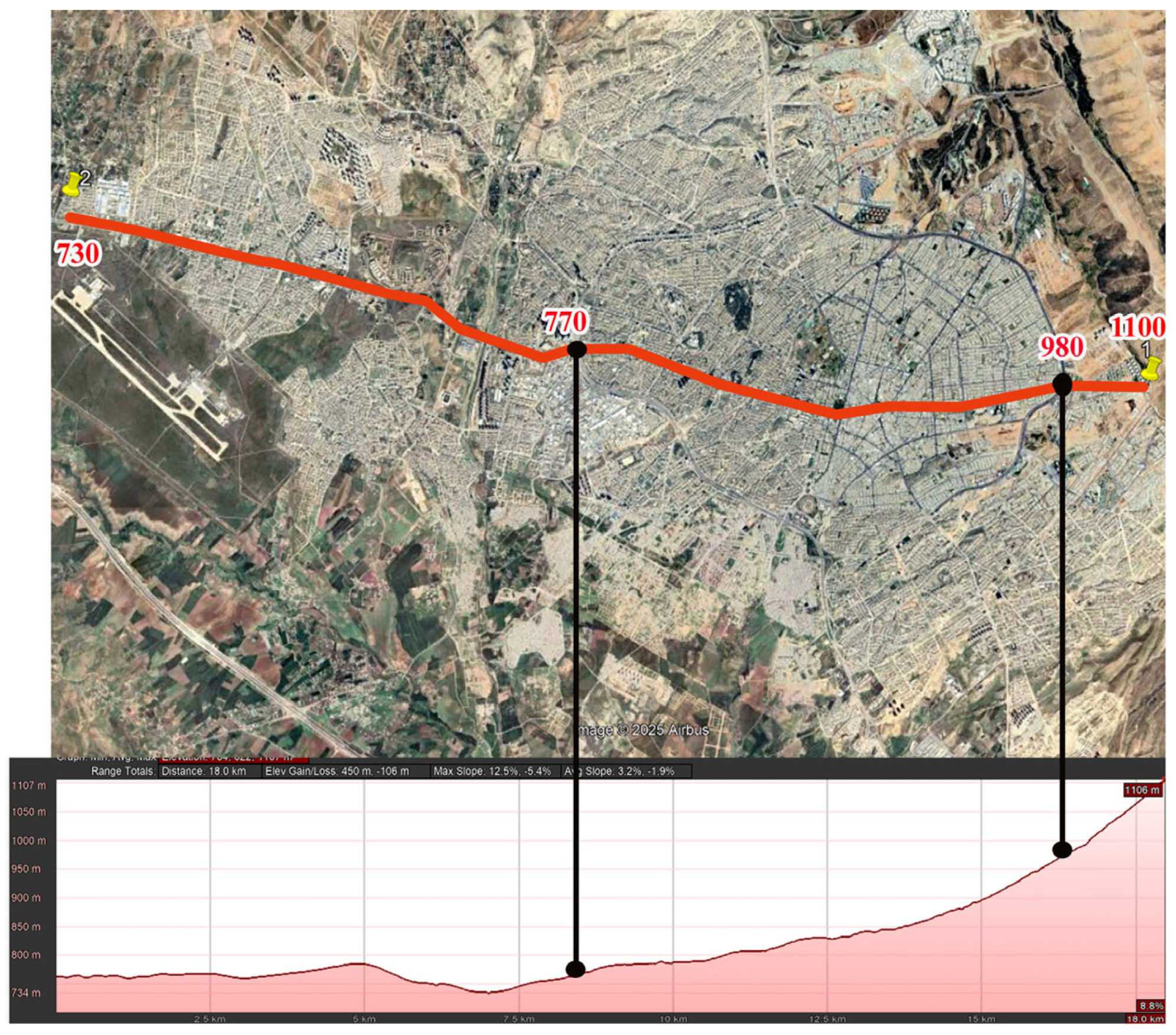


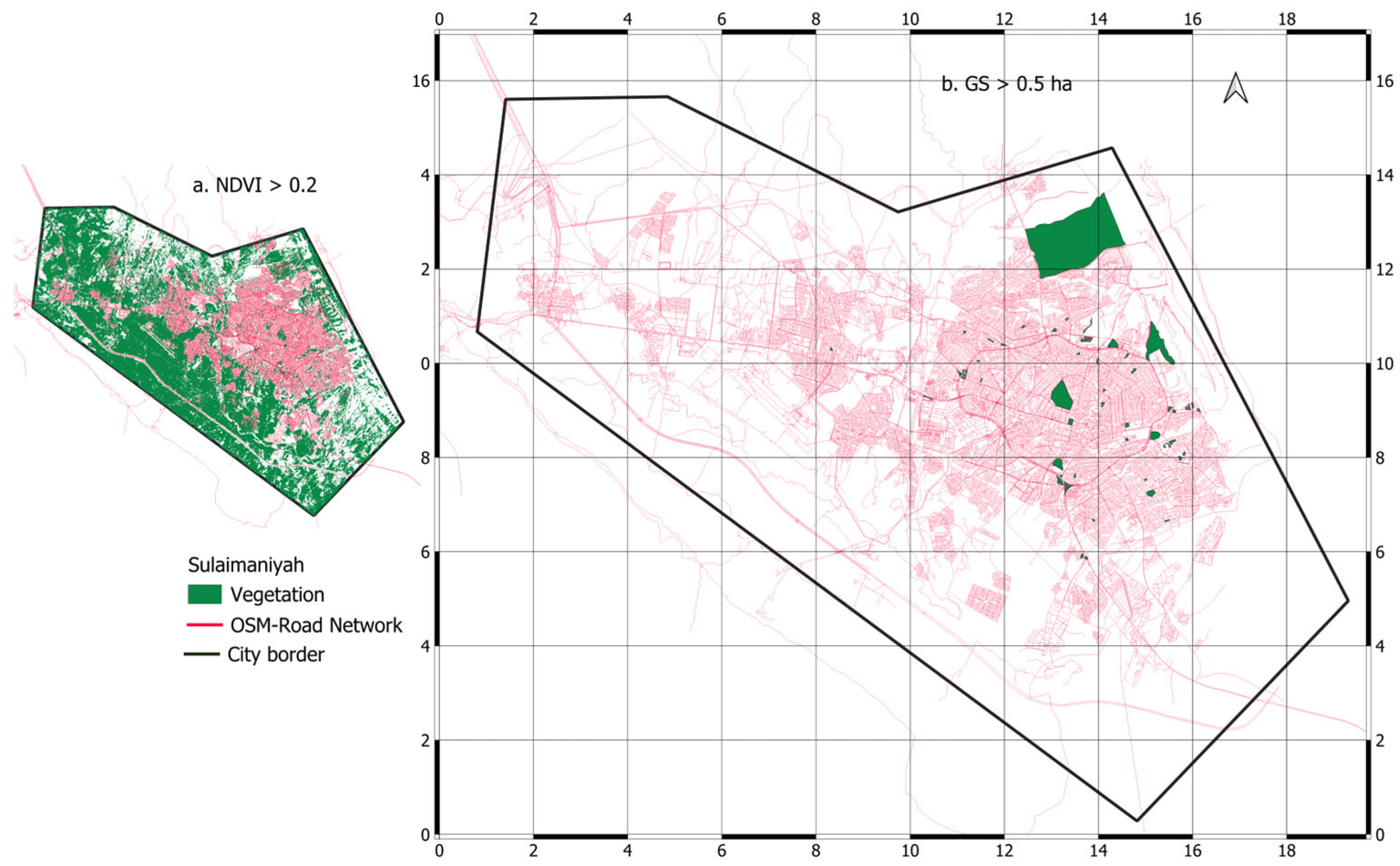
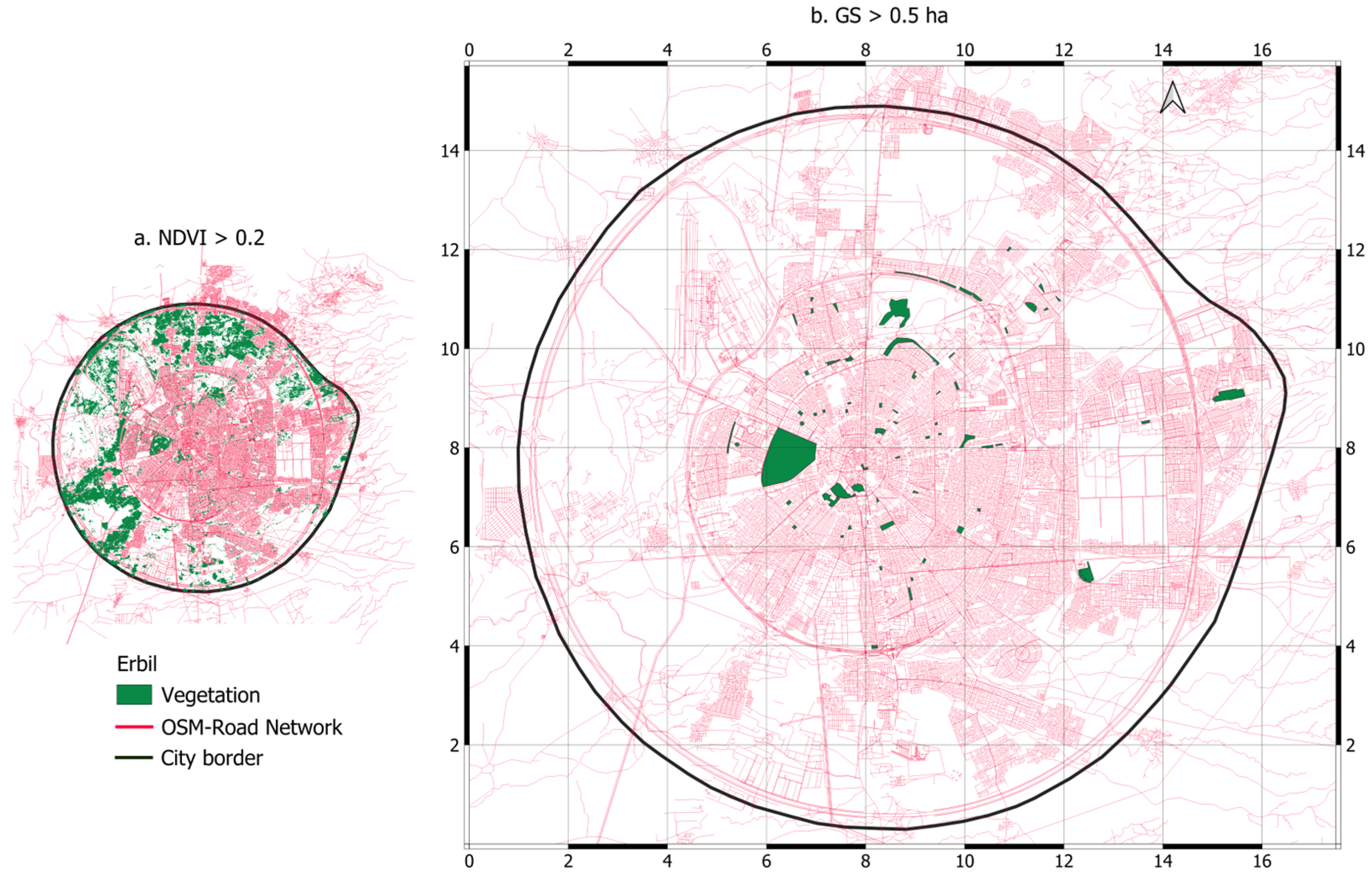
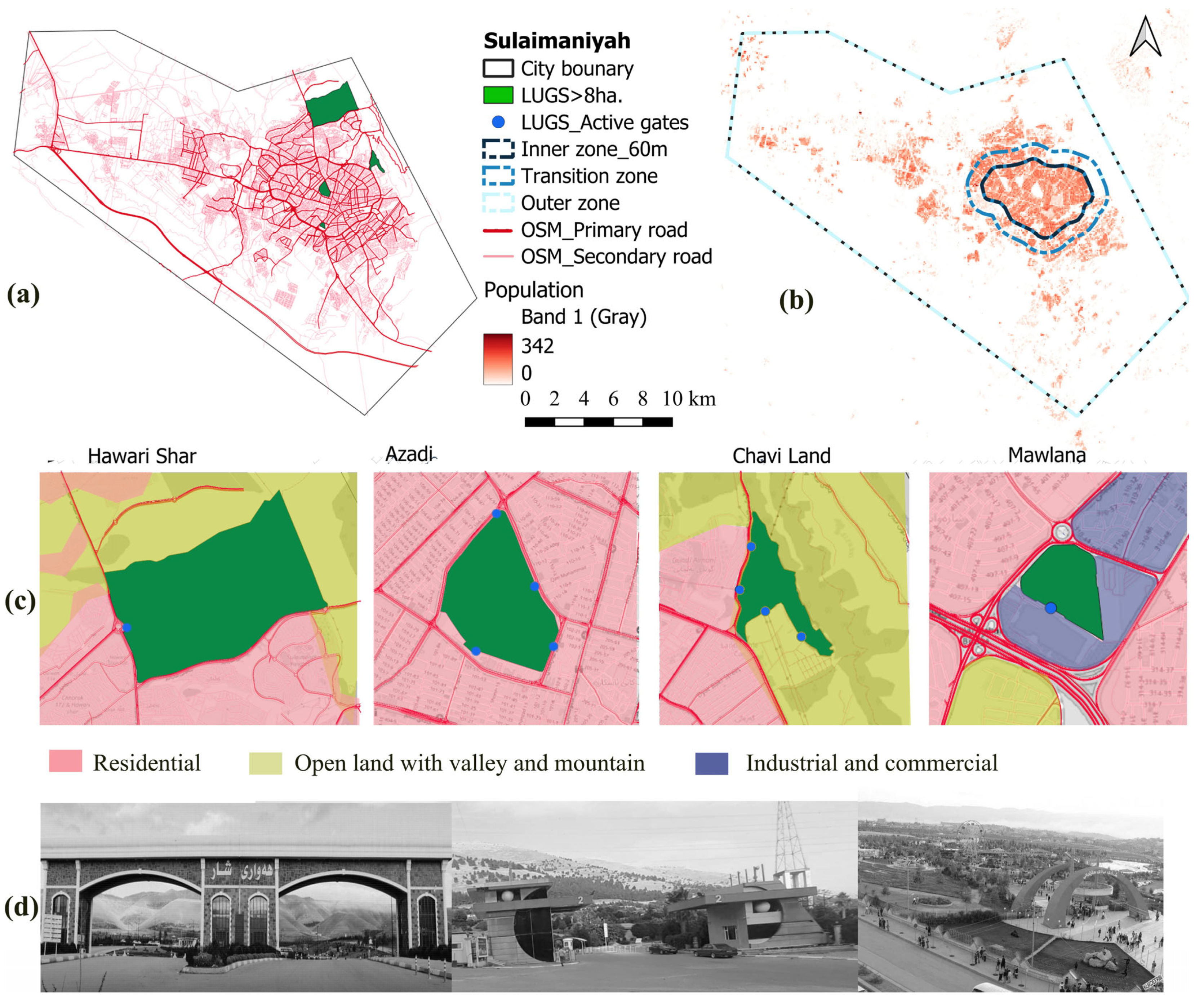
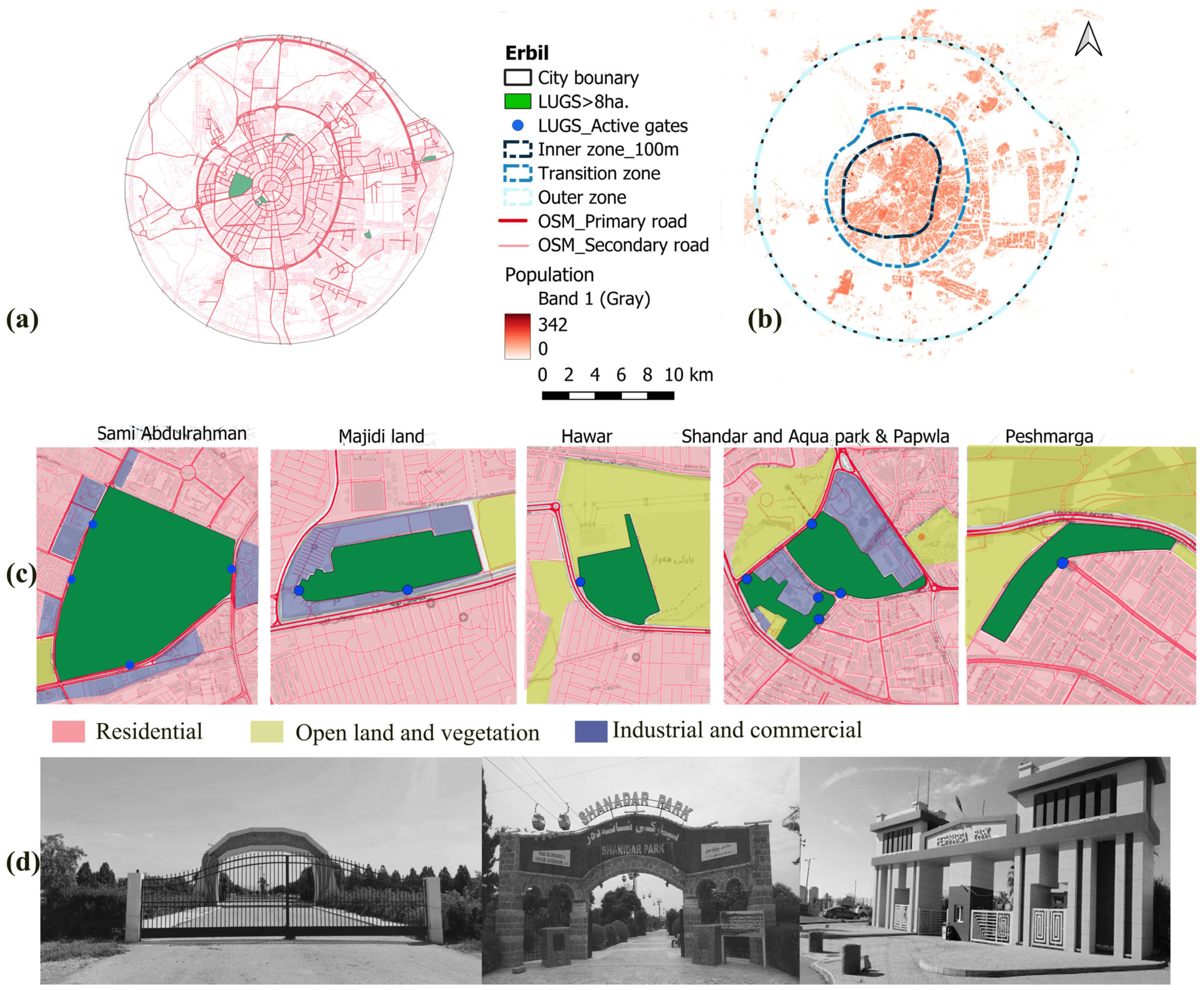
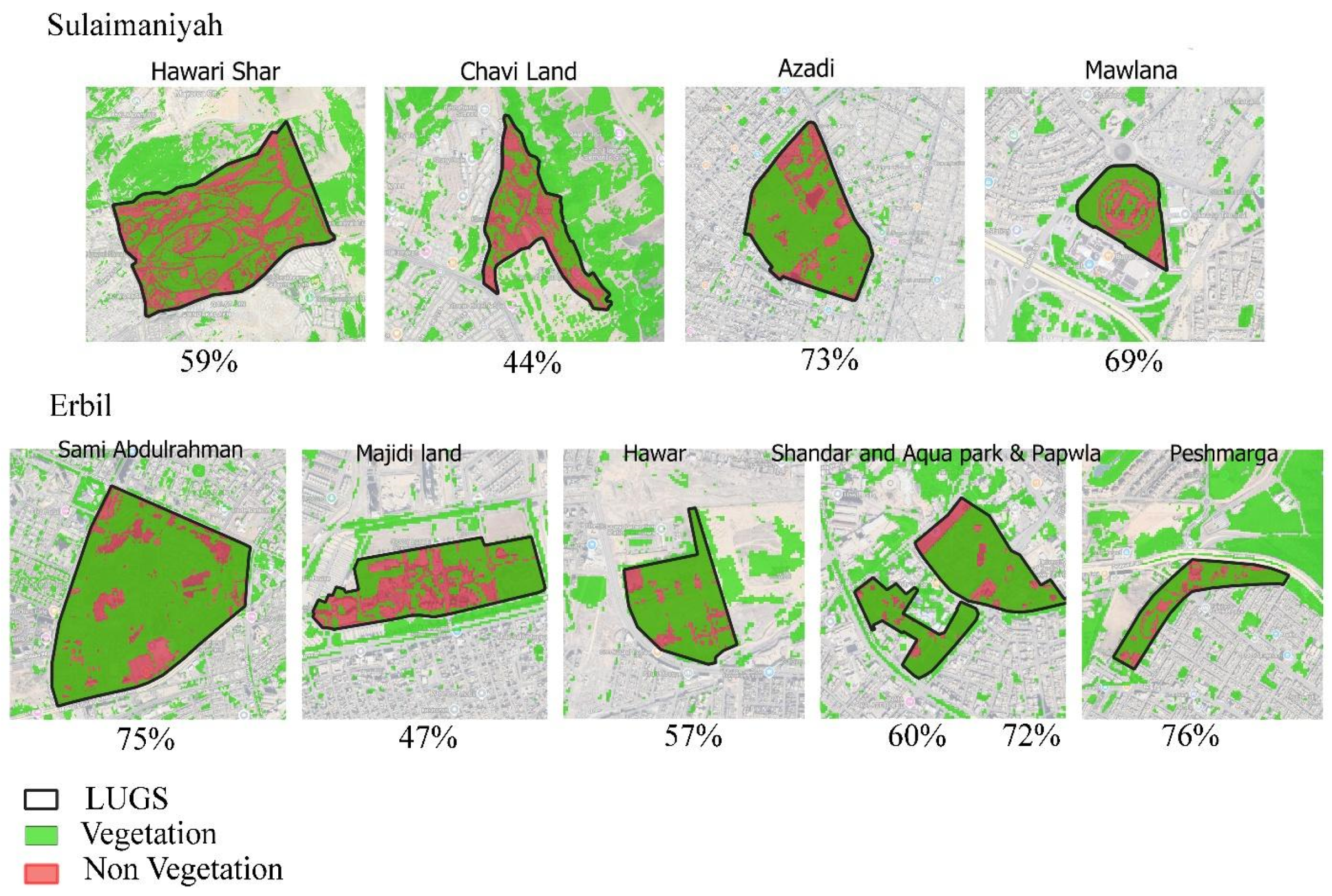
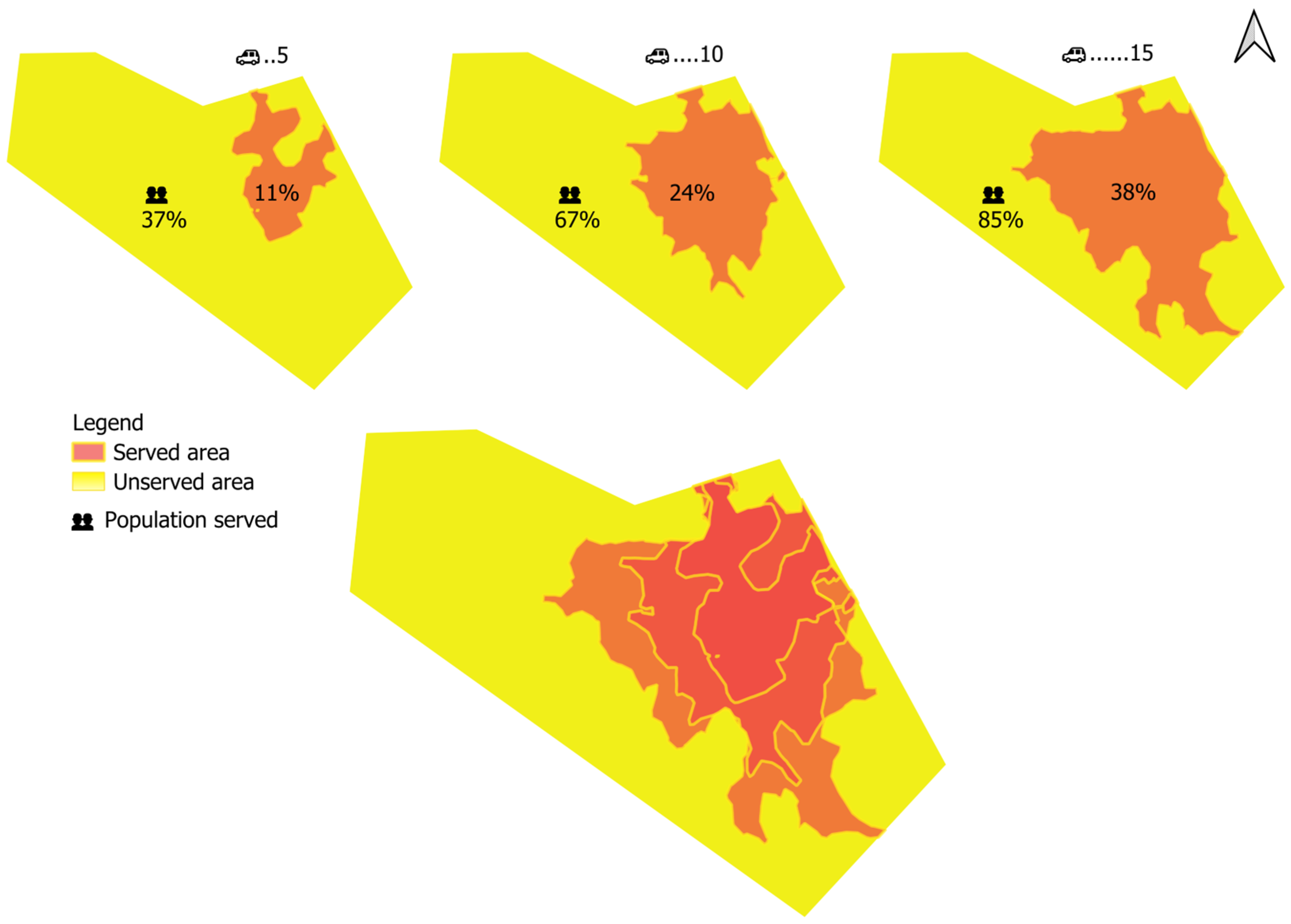

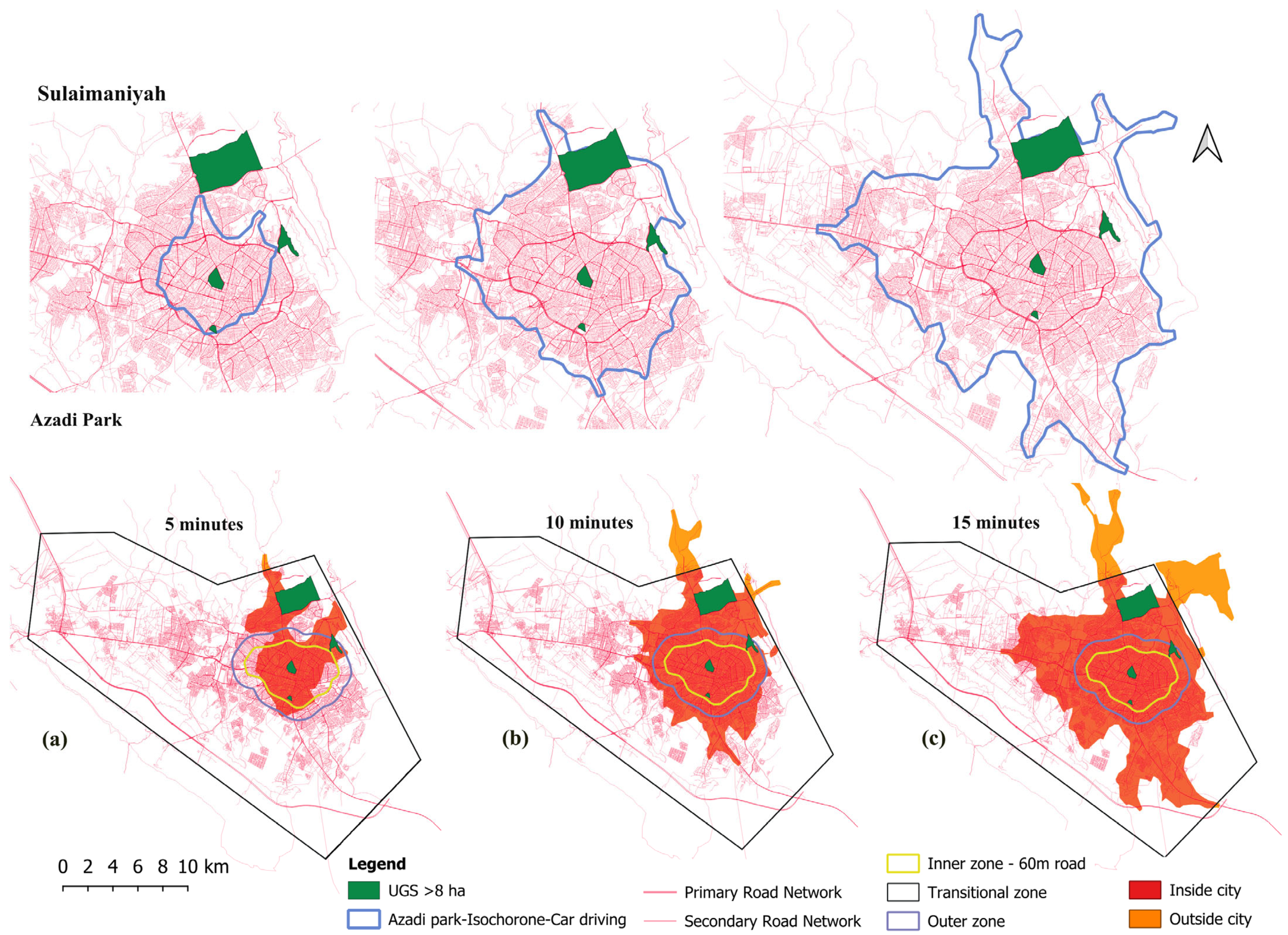

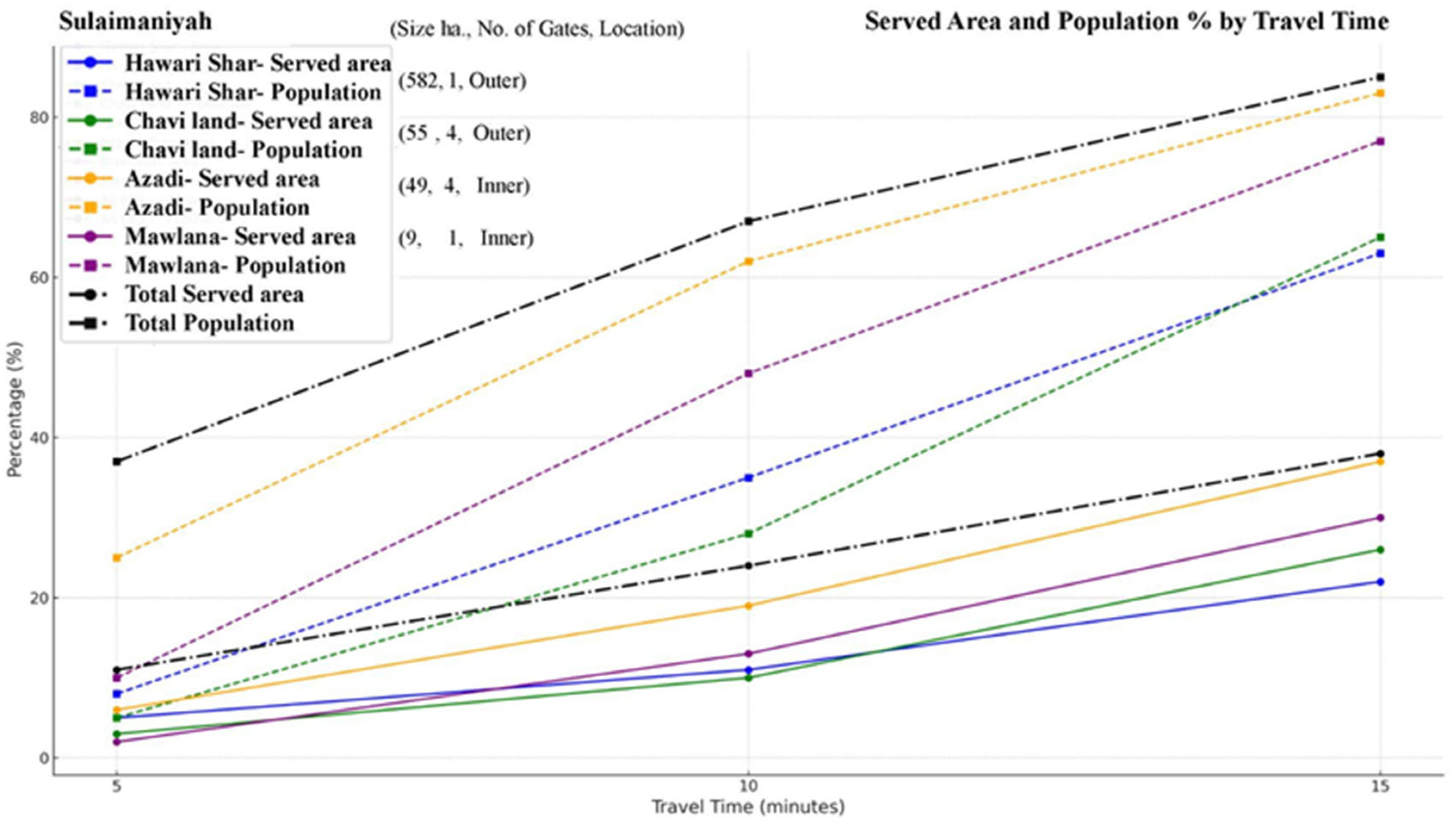
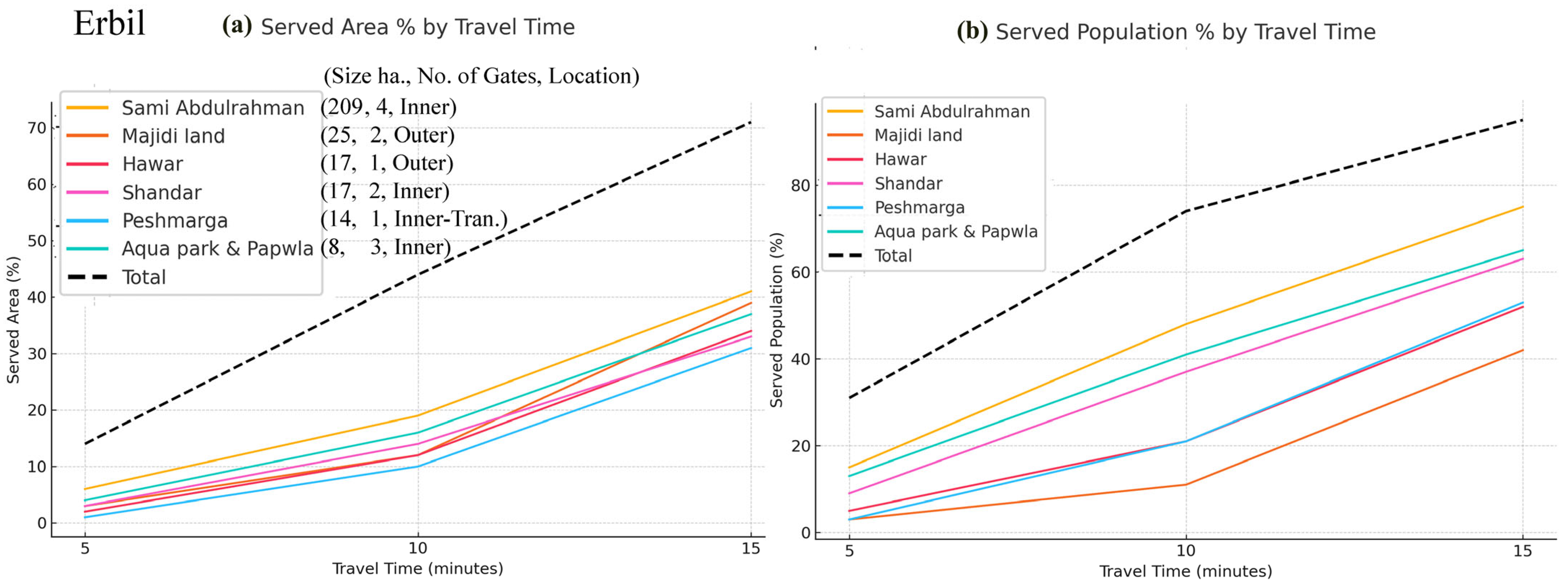
| Sulaimaiyah LUGS | Size Ha. | Active Gate | Erbil LUGS | Size Ha. | Active Gate |
|---|---|---|---|---|---|
| Hawari Shar Park | 582 | 1 | Sami Abdulrahman Park | 209 | 4 |
| Chavi land | 55 | 4 | Majidi land | 25 | 2 |
| Azadi Park | 49 | 4 | Hawar Park | 17 | 1 |
| Mawlana Park | 9 | 1 | Shandar Park | 17 | 2 |
| Peshmarga Park | 14 | 1 | |||
| * Aqua & Papwla Park | 8 | 4 |
Disclaimer/Publisher’s Note: The statements, opinions and data contained in all publications are solely those of the individual author(s) and contributor(s) and not of MDPI and/or the editor(s). MDPI and/or the editor(s) disclaim responsibility for any injury to people or property resulting from any ideas, methods, instructions or products referred to in the content. |
© 2025 by the authors. Licensee MDPI, Basel, Switzerland. This article is an open access article distributed under the terms and conditions of the Creative Commons Attribution (CC BY) license (https://creativecommons.org/licenses/by/4.0/).
Share and Cite
Hassan, Y.N.; Mohammed, H.A.; Abuhayya, M.; Jombach, S. Assessing Travel-Time Accessibility to Urban Green Spaces in Car-Dependent Cities: Evidence from Erbil and Sulaimaniyah, Kurdistan Region of Iraq. Land 2025, 14, 1886. https://doi.org/10.3390/land14091886
Hassan YN, Mohammed HA, Abuhayya M, Jombach S. Assessing Travel-Time Accessibility to Urban Green Spaces in Car-Dependent Cities: Evidence from Erbil and Sulaimaniyah, Kurdistan Region of Iraq. Land. 2025; 14(9):1886. https://doi.org/10.3390/land14091886
Chicago/Turabian StyleHassan, Yaseen N., Hawzheen A. Mohammed, Mahmoud Abuhayya, and Sándor Jombach. 2025. "Assessing Travel-Time Accessibility to Urban Green Spaces in Car-Dependent Cities: Evidence from Erbil and Sulaimaniyah, Kurdistan Region of Iraq" Land 14, no. 9: 1886. https://doi.org/10.3390/land14091886
APA StyleHassan, Y. N., Mohammed, H. A., Abuhayya, M., & Jombach, S. (2025). Assessing Travel-Time Accessibility to Urban Green Spaces in Car-Dependent Cities: Evidence from Erbil and Sulaimaniyah, Kurdistan Region of Iraq. Land, 14(9), 1886. https://doi.org/10.3390/land14091886








